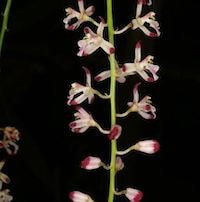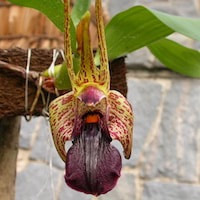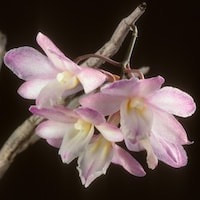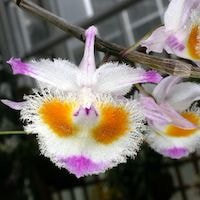WC2- Women's Citrus 2 - Apples and Oranges
|
Native Singaporean Orchid notes: Coelogyne Mayeriana
Used in Citrus 2 (Women) for Team building Perfume workshopThis species has a pleasant lemon scent and is known for its transparent, apple-green petals. Its flowers only last a few days. Originally extinct in Singapore, it was rediscovered in Malaysia, Sumatra, Java, the Philippines, and Borneo. It thrives in lowland forests up to 100 meters. Luckily, it has been reintroduced to parks and roadsides in Singapore. The scent attracts wasps, which pollinate the flowers, drawn by its lemon and lime flower fragrance.
|
Therapeutic Orchid notes:
|
Acriopsis liliifolia
The orchid Acriopsis liliifolia, known by various Malay names, grows in Southeast Asian lowland forests and on roadside trees. Ants are attracted to its pseudobulbs due to lipids on the seed coats, helping spread the orchid. In the past, its leaves and roots were used in Malaya as a fever reducer. In Indonesia, the orchid's juice treated earaches, while its powdered pseudobulb eased fever and hypertension. In India, its roots were used for rheumatism treatment in the Western Ghats. |
|
Dendrobium amplum Lindl. syn. Epigeneium amplum (Lindl.) Summerh.
This orchid, known as Kuanyehouchun Lan in Chinese, and by other names in Thai, grows on trees and rocks in mountain forests. In Chinese medicine, the whole plant is used. It's known for nourishing yin, relieving coughs, and improving blood circulation. |
|
Dendrobium cumulatum Lindl.
Thai names for this orchid include Thian phaya in, thian thong, and Uang sai si dok. It is found in Nepal, Bhutan, northeast India, Myanmar, Thailand, Indochina, and Borneo. Phytochemical analysis identified two compounds, cumulatin and tristin, from Dendrobium cumulatum and Bulbophyllum triste. The stems of these orchids are used in herbal medicine to treat asthma. |
|
Dendrobium denneanum Kerr syn. Dendrobium aurianticum Rchb
Known as Ma pien Shihu in Chinese, these orchids grow as epiphytes on trees in forests across Yunnan, Guizhou, Guangxi, Hainan, and Taiwan. Phytochemical studies have shown they possess antioxidant and immune-modulatory properties in laboratory tests. In traditional herbal medicine, Dendrobium denneanum is used as a tonic. |
Other scent note
Scentopia Library Reference ingredient
Download the guided mediation that works best with this Orchid fragrance oil
| women_citrus_essential_oil_orchi_00002.mp3 | |
| File Size: | 226873 kb |
| File Type: | mp3 |




